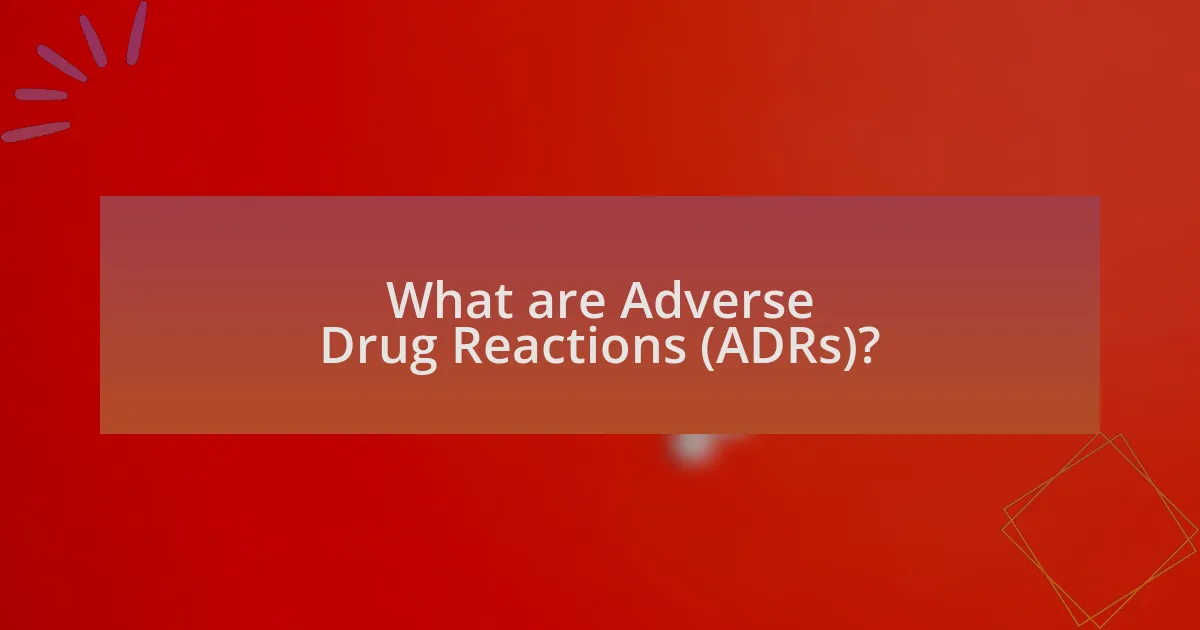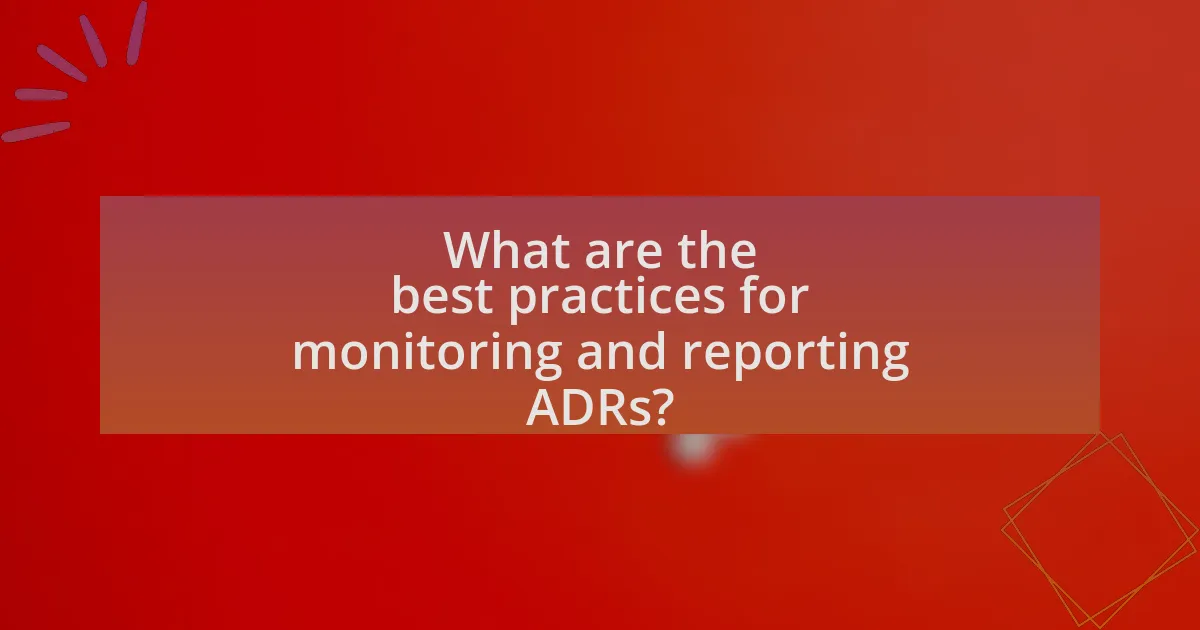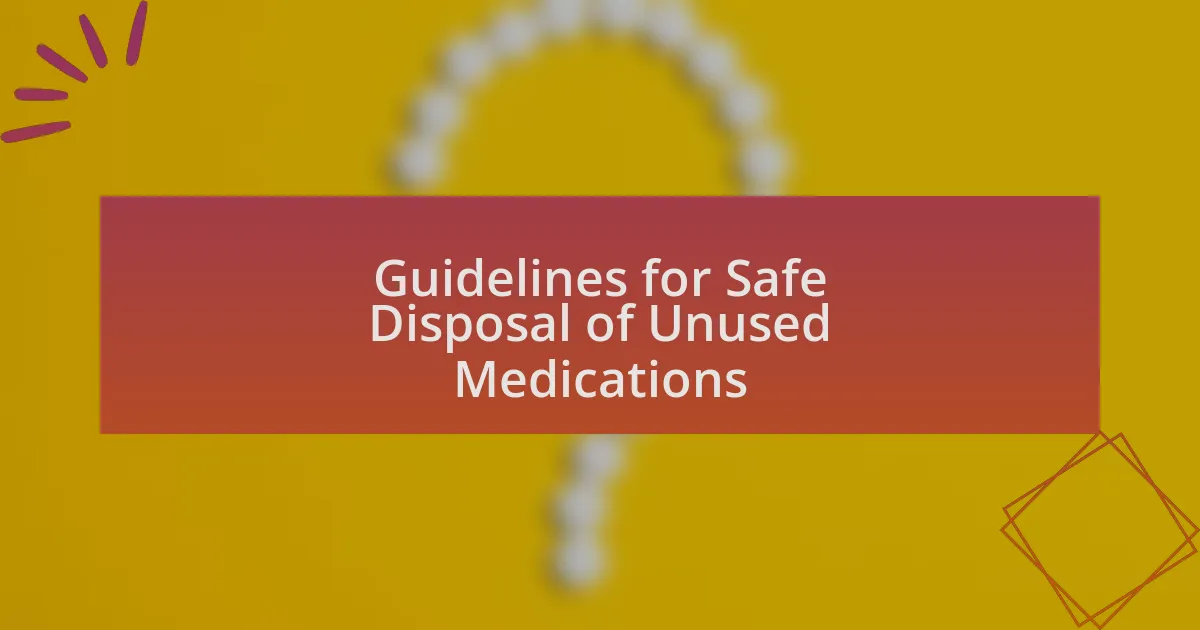Adverse Drug Reactions (ADRs) are harmful or unintended responses to medications that can occur even at normal doses, significantly impacting patient safety and treatment efficacy. This article outlines the various types of ADRs, their symptoms, and the importance of monitoring them to enhance patient health outcomes. It discusses strategies for reducing ADRs, including medication reconciliation, patient education, and the use of technology such as electronic health records and clinical decision support systems. Additionally, the article emphasizes the role of healthcare providers and patients in ADR reporting and management, highlighting best practices for improving medication safety and minimizing risks associated with drug therapies.
What are Adverse Drug Reactions (ADRs)?

Adverse Drug Reactions (ADRs) are harmful or unintended responses to medications that occur at normal doses. These reactions can range from mild side effects to severe health complications, impacting patient safety and treatment efficacy. According to the World Health Organization, ADRs are a significant cause of morbidity and mortality, with estimates suggesting that they account for approximately 5-10% of hospital admissions.
How do ADRs impact patient health?
Adverse Drug Reactions (ADRs) significantly impact patient health by causing a range of harmful effects, including increased morbidity, prolonged hospital stays, and even mortality. Studies indicate that ADRs are responsible for approximately 5-10% of hospital admissions, highlighting their critical role in patient health outcomes. Furthermore, ADRs can lead to additional healthcare costs, estimated at billions annually, due to the need for further treatment and management of complications arising from these reactions.
What are the common symptoms of ADRs?
Common symptoms of adverse drug reactions (ADRs) include nausea, vomiting, diarrhea, rash, dizziness, and fatigue. These symptoms can vary in severity and may occur shortly after medication administration or after prolonged use. According to the World Health Organization, ADRs can lead to significant morbidity and may require medical intervention, highlighting the importance of monitoring patients for these symptoms during treatment.
Why is it important to monitor ADRs in patients?
Monitoring adverse drug reactions (ADRs) in patients is crucial for ensuring patient safety and optimizing therapeutic outcomes. By systematically tracking ADRs, healthcare providers can identify harmful effects of medications, allowing for timely interventions that can prevent serious complications. Research indicates that ADRs are a significant cause of morbidity and mortality, with estimates suggesting that they account for approximately 5-10% of hospital admissions. This underscores the necessity of vigilant monitoring to mitigate risks associated with drug therapies and enhance overall patient care.
What are the types of ADRs?
Adverse Drug Reactions (ADRs) are classified into two main types: Type A and Type B. Type A reactions, also known as predictable reactions, occur due to the pharmacological effects of the drug and are dose-dependent, making them more common and often preventable. Examples include side effects like drowsiness from antihistamines or gastrointestinal upset from nonsteroidal anti-inflammatory drugs. Type B reactions, or unpredictable reactions, are not related to the drug’s pharmacological action and can occur in susceptible individuals, such as allergic reactions or idiosyncratic responses. These reactions are less common and can be more severe, often requiring immediate medical attention.
How are ADRs classified based on severity?
ADRs, or Adverse Drug Reactions, are classified based on severity into three main categories: mild, moderate, and severe. Mild ADRs typically cause minimal discomfort and do not require medical intervention, while moderate ADRs may necessitate a change in therapy or additional treatment. Severe ADRs can lead to significant health risks, hospitalization, or even death, necessitating immediate medical attention. This classification helps healthcare professionals assess the impact of ADRs on patient safety and treatment outcomes.
What are the differences between Type A and Type B ADRs?
Type A adverse drug reactions (ADRs) are dose-dependent and predictable, often resulting from the pharmacological effects of a drug, while Type B ADRs are idiosyncratic, unpredictable, and not dose-dependent, typically arising from immune-mediated responses or genetic factors. Type A reactions account for the majority of ADRs and can often be managed by dose adjustment or discontinuation of the drug, whereas Type B reactions may require more complex management strategies, including avoidance of the offending drug and potential use of alternative therapies.
What strategies can be employed to reduce ADRs?

To reduce adverse drug reactions (ADRs), implementing strategies such as thorough medication reconciliation, patient education, and regular monitoring of drug interactions is essential. Medication reconciliation ensures that healthcare providers have an accurate list of all medications a patient is taking, which helps identify potential ADRs before they occur. Patient education empowers individuals to understand their medications, including potential side effects and the importance of adherence, thereby reducing the likelihood of ADRs. Additionally, regular monitoring of drug interactions, particularly in patients with multiple prescriptions, can help detect and mitigate ADRs early. Studies have shown that these strategies significantly decrease the incidence of ADRs, enhancing patient safety and treatment efficacy.
How can healthcare providers improve medication safety?
Healthcare providers can improve medication safety by implementing standardized protocols for prescribing, administering, and monitoring medications. These protocols help minimize errors and ensure that patients receive the correct dosages and medications. For instance, the use of electronic health records (EHRs) with integrated clinical decision support systems has been shown to reduce medication errors by providing alerts for potential drug interactions and allergies. A study published in the Journal of the American Medical Informatics Association found that EHRs can decrease adverse drug events by up to 50% when used effectively. Additionally, regular training and education for healthcare staff on medication management can further enhance safety by keeping providers informed about best practices and emerging drug information.
What role does patient education play in reducing ADRs?
Patient education plays a crucial role in reducing adverse drug reactions (ADRs) by empowering patients with knowledge about their medications. Educated patients are more likely to understand the importance of adherence to prescribed regimens, recognize potential side effects, and communicate effectively with healthcare providers. Studies indicate that effective patient education can lead to a significant decrease in ADRs; for instance, a systematic review published in the Journal of Patient Safety found that targeted educational interventions reduced the incidence of ADRs by up to 30%. This evidence underscores the importance of comprehensive patient education as a strategy for minimizing the risks associated with medication use.
How can medication reconciliation help prevent ADRs?
Medication reconciliation can help prevent adverse drug reactions (ADRs) by ensuring accurate and comprehensive medication lists are maintained throughout patient care transitions. This process involves comparing a patient’s current medications with those prescribed during healthcare visits, which helps identify discrepancies such as omissions, duplications, or incorrect dosages. Studies have shown that effective medication reconciliation can reduce the incidence of ADRs by up to 50%, as it allows healthcare providers to make informed decisions and adjustments to medication regimens based on a complete understanding of a patient’s medication history.
What technological solutions are available to minimize ADRs?
Technological solutions available to minimize adverse drug reactions (ADRs) include electronic health records (EHRs), clinical decision support systems (CDSS), and pharmacogenomics. EHRs facilitate the comprehensive tracking of patient medication histories, enabling healthcare providers to identify potential drug interactions and allergies. CDSS provides real-time alerts and recommendations based on patient data, which helps clinicians make informed prescribing decisions. Pharmacogenomics analyzes how an individual’s genetic makeup affects their response to medications, allowing for personalized treatment plans that reduce the likelihood of ADRs. These technologies collectively enhance patient safety and improve medication management, as evidenced by studies showing a reduction in ADR rates when these systems are implemented in clinical settings.
How do electronic health records contribute to ADR reduction?
Electronic health records (EHRs) contribute to the reduction of adverse drug reactions (ADRs) by enabling better medication management and facilitating real-time access to patient data. EHRs provide healthcare providers with comprehensive medication histories, which help in identifying potential drug interactions and allergies. For instance, studies have shown that EHRs equipped with clinical decision support systems can alert clinicians to potential ADRs before prescribing medications, significantly decreasing the incidence of harmful reactions. Additionally, EHRs enhance communication among healthcare teams, ensuring that all providers are aware of a patient’s medication regimen, which further minimizes the risk of ADRs.
What are the benefits of using clinical decision support systems?
Clinical decision support systems (CDSS) enhance patient safety and care quality by providing healthcare professionals with evidence-based knowledge and patient-specific information. These systems reduce the likelihood of adverse drug reactions by alerting clinicians to potential drug interactions, allergies, and contraindications during the prescribing process. Research indicates that the implementation of CDSS can lead to a significant decrease in medication errors, with studies showing reductions of up to 50% in certain settings. Additionally, CDSS can improve adherence to clinical guidelines, ensuring that patients receive appropriate treatments based on the latest medical evidence.
What are the best practices for monitoring and reporting ADRs?

The best practices for monitoring and reporting Adverse Drug Reactions (ADRs) include establishing a systematic approach for data collection, utilizing standardized reporting forms, and ensuring timely communication among healthcare professionals. A systematic approach allows for consistent tracking of ADRs, which enhances the ability to identify patterns and potential safety signals. Standardized reporting forms facilitate uniformity in data collection, making it easier to analyze and compare ADR reports. Timely communication among healthcare professionals ensures that all relevant parties are informed about ADRs, which can lead to quicker interventions and improved patient safety. These practices are supported by regulatory guidelines from organizations such as the World Health Organization and the U.S. Food and Drug Administration, which emphasize the importance of robust ADR monitoring systems in enhancing drug safety.
How can healthcare systems enhance ADR reporting?
Healthcare systems can enhance Adverse Drug Reaction (ADR) reporting by implementing standardized reporting protocols and utilizing electronic health records (EHRs) to streamline data collection. Standardized protocols ensure consistency in reporting, making it easier for healthcare professionals to document ADRs accurately. The integration of EHRs facilitates real-time reporting and analysis of ADRs, allowing for quicker identification of patterns and potential safety issues. According to a study published in the Journal of Patient Safety, hospitals that adopted EHR systems saw a 30% increase in ADR reporting rates, demonstrating the effectiveness of technology in improving reporting practices.
What are the key components of an effective ADR reporting system?
An effective ADR reporting system includes several key components: a standardized reporting process, comprehensive training for healthcare professionals, a user-friendly reporting platform, and robust data analysis capabilities. The standardized reporting process ensures consistency in how adverse drug reactions are documented and communicated, which is crucial for accurate data collection. Comprehensive training equips healthcare professionals with the knowledge to recognize and report ADRs effectively, enhancing the quality of the data collected. A user-friendly reporting platform encourages more healthcare providers to participate in the reporting process, thereby increasing the volume of data available for analysis. Finally, robust data analysis capabilities allow for the identification of trends and patterns in ADRs, facilitating timely interventions and improving patient safety. These components collectively contribute to a more effective ADR reporting system, ultimately aiding in the reduction of adverse drug reactions in patients.
How can feedback from ADR reports improve patient safety?
Feedback from Adverse Drug Reaction (ADR) reports can significantly improve patient safety by identifying and mitigating risks associated with medications. By analyzing these reports, healthcare professionals can recognize patterns of adverse effects, leading to better risk assessment and management strategies. For instance, a study published in the Journal of Patient Safety found that systematic review of ADR reports led to a 30% reduction in medication errors in a clinical setting. This data underscores the importance of utilizing ADR feedback to enhance prescribing practices, inform patient education, and refine clinical guidelines, ultimately fostering a safer healthcare environment.
What role do patients play in ADR monitoring?
Patients play a crucial role in Adverse Drug Reaction (ADR) monitoring by actively reporting their experiences with medications. Their firsthand accounts provide valuable data that healthcare professionals use to identify and assess potential ADRs, which can lead to improved patient safety and medication management. Studies indicate that patient-reported outcomes can significantly enhance the detection of ADRs, as patients often notice side effects that may not be captured during clinical trials or routine monitoring. For instance, research published in the Journal of Patient Safety highlights that patient engagement in ADR reporting can lead to a 30% increase in the identification of previously unrecognized drug reactions.
How can patients effectively communicate their experiences with medications?
Patients can effectively communicate their experiences with medications by providing detailed information about their symptoms, side effects, and overall treatment outcomes to healthcare providers. This includes describing the onset, duration, and intensity of any side effects experienced, as well as any changes in their health status since starting the medication. Research indicates that clear communication can lead to better medication management and reduced adverse drug reactions, as healthcare providers can make informed decisions based on the patient’s feedback. For instance, a study published in the Journal of Patient Safety highlights that patients who actively engage in discussions about their medication experiences contribute to improved safety and efficacy in their treatment plans.
What resources are available for patients to report ADRs?
Patients can report adverse drug reactions (ADRs) through several resources, including the Food and Drug Administration’s (FDA) MedWatch program, which allows individuals to submit reports online, by mail, or by fax. Additionally, many pharmaceutical companies have their own reporting systems, often accessible via their websites, where patients can report ADRs directly. Healthcare providers also play a crucial role, as they can facilitate the reporting process through their clinical practices. Furthermore, patient advocacy organizations often provide guidance and support for reporting ADRs, ensuring that patients have multiple avenues to communicate their experiences.
What practical tips can healthcare providers implement to reduce ADRs?
Healthcare providers can implement several practical tips to reduce adverse drug reactions (ADRs). First, conducting thorough medication reconciliation during patient admissions, transfers, and discharges can identify potential drug interactions and discrepancies. Studies show that medication reconciliation can reduce ADRs by up to 50%. Second, providers should utilize clinical decision support systems that alert prescribers to potential drug interactions and allergies, which have been shown to decrease the incidence of ADRs significantly. Third, educating patients about their medications, including potential side effects and the importance of adherence, can empower them to report any adverse effects early. Research indicates that patient education can lead to a 30% reduction in ADRs. Lastly, regular monitoring of patients on high-risk medications, such as anticoagulants and opioids, is essential, as proactive management can prevent complications associated with these drugs.





